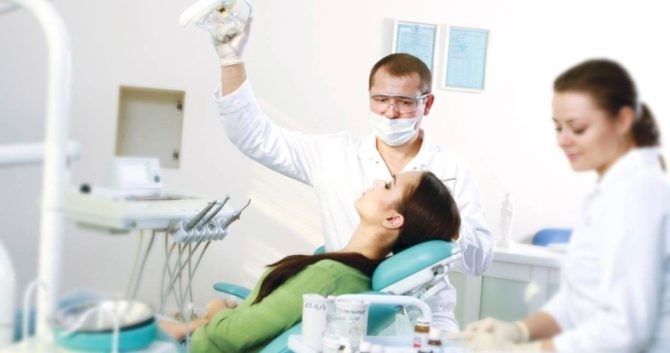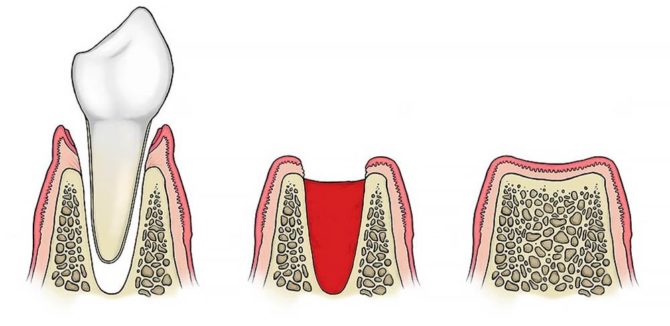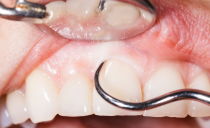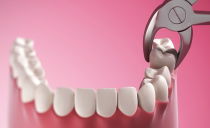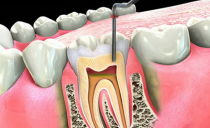Healing of the gums and holes after tooth extraction: terms and step-by-step photos
How many gums heal after removing a wisdom tooth or an ordinary molar - sooner or later almost any person has to think about it. Hard connective tooth tissue lacks the ability to regenerate, but they are damaged throughout life.
When the lesions become very deep, pain and pathological processes begin in the pulp, the gum itself. To prevent further human suffering and possible complications, this unpleasant, but necessary mini-operation is performed. After the intervention, complete healing should occur.
Content
The essence of tooth extraction manipulation
To remove (extract) a tooth, soft tissues have to be injured. During the procedure, severe pain occurs, so in most cases an anesthetic injection is performed.
When the anesthesia worked, the dentist slightly turns the gum and covers the tooth neck and the upper part of the root with forceps, then the extraction itself takes place.
The consequences of this manipulation are as follows:
- The blood vessels that used to enter the pulp and feed the dental tissues, rupture, bleeding opens.
- The nerve endings of the pulp and gums are irritated and damaged, so pain occurs. Until the action of anesthesia is completed, the patient does not feel it.
- Ligaments that fix the root in the jaw alveolus are torn.
- Upon completion of the anesthesia, there is a feeling of discomfort when chewing or talking.
- All these phenomena are perceived by the body, and a larger amount of blood is sent to the area of the hole, an inflammatory process develops. This is necessary to increase local immunity: leukocytes seep through the walls of the capillaries to fight the infection that could have entered there, and to remove the destroyed own cells of the body.
Duration of healing of the gums (holes) after tooth extraction
The question of how long the gums heal after tooth extraction takes place involves two nuances. Soft tissue heals firstwhich in the absence of complications are finally restored within 7-14 days.
The restoration of the internal solid components of the jaw, the stages of bone formation take much longer and are completed by the eighth month. An empty alveolus overgrows, its cavity is filled with connective granulation tissue, overgrown with epithelium on top.
The rate of overgrowth directly depends on how large the wound is. The hole after the removal of the wisdom tooth with its curved roots is delayed more slowly than as a result of tearing out the same root incisor - the first and second tooth, or the canine - the third in a row.
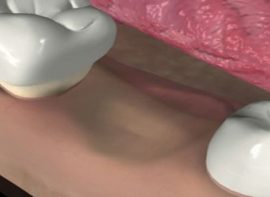 Molar (fourth and seventh) has a greater number of roots, so the place of its removal heals longer. In the photo you can see how the hole heals after removing the fourth tooth.
Molar (fourth and seventh) has a greater number of roots, so the place of its removal heals longer. In the photo you can see how the hole heals after removing the fourth tooth.
If the regeneration process proceeds normally, bleeding stops during the first two hours, as the holes formed in the alveoli vascular system are tightened.
The pain can subside when the restoration of the gums, vascular network and nerve endings ends: in about a week. During this period, swelling of the cheeks and gums, redness of the mucous membrane goes away.If the hole is fully tightened and there is no discomfort, then the operation was successful.
Rules of conduct during the rehabilitation period
In order for granulation and regeneration of the epithelium to proceed successfully, the patient must adhere to several rules that the dentist usually talks about. General recommendations for the normal healing process of the hole after tooth extraction are as follows:
- A tampon containing a disinfecting solution and left by the doctor in the hole can be removed no earlier than half an hour after the procedure.
- After the tooth is removed, you cannot touch the wound with your fingers, tongue, foreign objects, try to remove or rinse the blood clot, and remove the stitches made by the dentist.
- You should avoid situations that can increase blood circulation and cause bleeding: you should not visit the bathhouse, overload the body with hard work and sports, sunbathe, apply warming compresses to your cheek, eat hot food.
- Do not chew food on the side of the oral cavity where the intervention took place. She can get into a wound and undergo rot there. In the first 2-3 hours, in general, you can’t eat.
- Alcohol consumption and smoking irritate the mouth, therefore healing of the gums after tooth extraction in people with bad habits is slower.
- The hole after tooth extraction looks unpleasant, many people in the postoperative period are afraid to brush their teeth. But we should not forget about hygiene - already after 8 hours after the operation, you can start cleaning, which must be done twice a day.
These recommendations should be followed for 1.5–2 weeks, until the mucous membranes of the mouth are completely restored.
Taking medication after surgery
In dentistry, after the procedure, the doctor prescribes the necessary drugs:
 In order to accelerate the healing of the socket of the extracted tooth, the dental healing cream Solcoseryl is used. Its components help the body regenerate damaged areas of the oral cavity faster.
In order to accelerate the healing of the socket of the extracted tooth, the dental healing cream Solcoseryl is used. Its components help the body regenerate damaged areas of the oral cavity faster.- If the patient is hypersensitive, and he is experiencing pain, he is credited with pain medication.
- When conducting an operation against a background of an infectious disease: illness of the throat, oral mucosa, care must be taken to prevent the entry of pathogens into the resulting wound. For this, an antibiotic is prescribed, which removes the infectious process and prevents its spread.
It is strictly forbidden to select medications for pain relief, accelerate healing, and even more so treat infections.
Removal Complications
It is not always possible to carry out surgical intervention without negative consequences. Sudden complications may occur during the procedure itself., which subsequently affect the healing of the gums after tooth extraction:
- The crown, neck or roots crumble and the lower parts get stuck in the gum.
- There is a dislocation of the second, neighboring tooth.
- There is a fracture of the lower jaw.
- A hole is formed in the upper jaw, through which the entrance to the maxillary sinus opens.
- Bleeding opens.
- A dry hole is formed. When the formed blood clot fell out immediately after extraction.
- The nerve is damaged.
Such deviations are immediately visible when performing the procedure. The doctor must take all necessary measures to eliminate them. Additional manipulations may be necessary: a too large wound with heavy bleeding is sutured, if any particles of the tooth remain in the alveolus, they are removed with surgical instruments.
In case of facial numbness due to a nerve disorder, physiotherapeutic procedures are prescribed. Their number depends on the degree of damage and the rate of development of sensitivity.
A dry well after tooth extraction is a cause for concern. The loss of a clot opens the way for the penetration of infections into the internal environment of the body. This is why antibiotics are prescribed for patients with a dry well.
Complications during the rehabilitation period
If the tooth was pulled out incorrectly, a complicated extraction was performed, an infection develops in the mouth, a part of the root in the alveolus remains, the patient has weak immunity or violates the rules of behavior during the rehabilitation period, other complications may develop:
- Alveolitis, or inflammation of the jaw alveoli.
- Infectious and inflammatory diseases of the jaw shells: periostitis, osteomyelitis.
- Infectious and inflammatory pathologies of the soft tissues of the neck and face: phlegmon, abscess.
- Recovery may be delayed due to complications of the cyst.
A doctor should be consulted if pain and swelling intensify, the wound surface is poorly tightened or inflamed, a fever with an increase in temperature appears, and the feeling of facial skin is lost. Such signs can be a manifestation of a complex pathology. The cause of the disorder and an accurate diagnosis are established by the dentist, who prescribes drugs and medical procedures to heal the wound.
If the operation went well, then the redness and swelling gradually decrease, and there are no spots or neoplasms.
You can ask the dentist to show how the tooth looks after removal, for example, the photo below shows the normal version, when the structure of the crown and roots is preserved, fragments do not form.
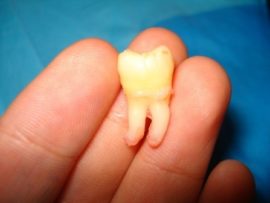 When the wound surface is not the same as in the photographs, black, with whitish or reddened swollen edges, you should not do any procedures yourself, try to remove the part of the root that rots there. The inflamed gum or its excessive dryness in the first time after surgery is an adverse symptom in which you should quickly consult a doctor.
When the wound surface is not the same as in the photographs, black, with whitish or reddened swollen edges, you should not do any procedures yourself, try to remove the part of the root that rots there. The inflamed gum or its excessive dryness in the first time after surgery is an adverse symptom in which you should quickly consult a doctor.
Thus, unpleasant symptoms after extraction disappear much faster than the regeneration stages go. In order for the hole to heal safely, you need to eat right: the intake of sufficient vitamins and minerals into the cells accelerates the formation of new tissues. Timely cleaning of the oral cavity prevents the multiplication of pathogens, and then the wound becomes inflamed much less often.
And do not drag out a visit to the dentist, if there is evidence for such an operation. The tooth can deteriorate under the influence of bacteria, provoke inflammation of the gums and ultimately fall out, which makes it much more difficult to treat the oral cavity.

